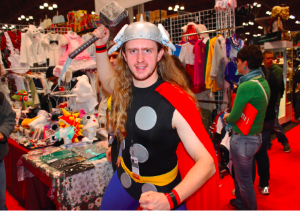
Sorry to call you out, but your costume is probably offending someone.
It’s a week until Halloween, and if you’re putting together a costume, you’re going to want to set aside some time to think about cultural appropriation.
Last year, the DSU’s Equity & Accessibility Office operated a table outside the Grawood the night of the Halloween party, stopping attendees whose cos- tumes they deemed offensive,and asking them to change into one of the pre-approved costumes that they had on hand.
Obviously no one wants to suffer the embarrassment of getting called out for insensitivity, but cultural appropriation can be a complex issue. Thankfully, last year, one of the coordinators of the E&A office provided students with a helpful set of guidelines to check in with before settling on a costume:
“1. Is my costume supposed to be funny? Is the humour based on making fun of real people, human traits or cultures?
2. Does my costume represent a culture that is not my own?
3. Does my costume reduce cultural differences to jokes or stereo- types?
4. Does my costume perpetuate stereotypes, misinformation, or historical and cultural inaccuracies?”
The rules may seem simple, but their implications reverberate to the core of the holiday.
Take my costume hunt, for example. At first, I figured I was safe. I’m a lazy Halloweener, and I’ve dressed up as a vampire every year for a solid decade now. Nothing offensive there, right?
Think again. Check out the second question on the E&A checklist:
“Does my costume represent a culture that is not my own?”
Our modern understanding of vampires comes from Bram Stoker, who appropriated the hell out of Eastern European folklore when crafting Dracula. These folklore beliefs are alive and well – a year ago, the town council of Zarozje, Serbia issued a public health alert about a possible vampire on the loose. Less than a decade ago, a group of villagers in Marotinu de Sus, Romania dug up suspected vampire Petre Toma, drove stakes through his body, sprinkled him with garlic, and fed the ashes of his burnt heart to his supposed victim.
Obviously, the vampire continues to play a hugely powerful cultural role in many parts of Eastern Europe. I don’t have any Eastern European heritage, and I haven’t lived the experience of drinking heart ashes or holding religious rituals to ward off vampire attacks, so popping in a set of fangs for fun one night a year seems a little insensitive in retrospect.
Sadly, the fearsome vampire took a sensitivity stake to the heart. Realizing this, I set out on a quest for a new, culturally sensitive costume.
I love J.K. Rowling, and I bear a striking resemblance to Severus Snape, but anything Harry Potter-related was out. While not quite as culturally offensive as dressing up as the hideous “Wicked Witch of the West” stereotype, there are tens of thousands of Wiccans (and other Pagans) in Canada who face real discrimination on a daily basis. Hollywood has appropriated, dumbed-down, and repackaged their deeply-held beliefs as horror and fantasy for decades now, making it nearly impossible for them to express their identity publicly without fear of ridicule or hostility. Probably not a great idea for me to perpetuate the suffering.
The list of classic (re:easy) costumes doesn’t get any better after witches and vampires. Zombies? Appropriated from Haitian folklore. Hobos? Only if you think it’s fun to play ‘dress up’ as one of the most disadvantaged subcultures in our society. Slathering on make-up, stuffing some balloons under your sweater and going out as a woman? If you’re a cis guy, odds are good that there isn’t enough space in this paper to list the offenses you’ve committed.
The easier options exhausted, I turned to superheroes – they had to be safe, right?
I grew up absolutely obsessed with Dragon Ball, but as a Japanese cultural icon drawing its inspiration from Chinese folk- lore and various Eastern religions/philosophies, that cast of characters was a non-starter. Marvel’s Thor seemed like he had potential for a time – I’m plenty pale and tall – but then I remembered that I know at least five Haligonians who practice Ásatrú (Germanic neo-paganism), and some of them might be a touch offended if I dressed up as the spandex-wearing Hollywood knockoff of one of their holiest deities.
Ultimately, I realized that the only way to be one hundred per- cent certain that my costume was culturally sensitive was to hit the books and do some serious research into the cultural practices of my own ancestors. It took some digging, but I eventually found an article by Dr. Bettina Arnold, an anthropology professor at the University of Milwaukee, entitled Halloween Customs in the Celtic World.
A sense of hope flooded over me. What better way to culture-proof my costume than to draw inspiration from the ancient practices of my own ancestors – practices that likely originated centuries (if not millennia) before the British peoples ever even encountered another modern culture to exploit or appropriate.
Finally, I had my answer:
“In Scotland, Halloween was a night of mischief and confusion. The spirits of the dead were impersonated by young men with… blackened faces, dressed in white or disguises of straw.”
Bingo. It’s supposed to be scary, not funny, it’s an ancient practice from the culture of my ancestors, it doesn’t reduce cultural differences to jokes or stereotypes, and it doesn’t perpetuate any misconceptions or cultural inaccuracies. Four for four.
So there you have it – if you come from a Celtic background, and you want to ensure perfect costume compliance with the sensitivity guidelines set by our friends at the E&A office, then blackening your face and throwing on a straw kilt appears to be your safest bet.
The Gazette accepts no responsibility for viral meme mockery, Tumblr condemnation, Daily Show segments, or old-fashioned mob justice that may result from such compliance with E&A guidelines.







